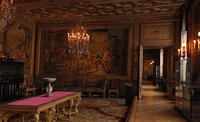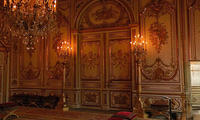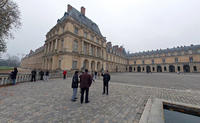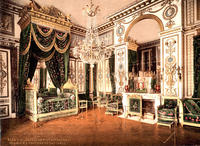You are in: Europe -> France -> Palace and Park of F... , and traditional search or Image Gallery will yield results of this site only
Palace and Park of Fontainebleau
| Site number: | 160 |
|
| Type of site: | Cultural | |
| Date: | 12-16 Centuries | |
| Date of Inscription: | 1981 | |
| Location: | Europe, France, Ile-de-France, Département of Seine-et-Marne | |
Up to 75 images are shown here. Click on each for more details or on Image Gallery for more images.
| Description: | The medieval royal hunting lodge of Fontainebleau that stands in the middle of a vast forest in the Ile-de-France has been used by the kings of France since the 12th century. In the 16th century the site was transformed, enlarged and embellished by François I, who envisioned a 'New Rome'. The Italianate palace, enclosed by an immense park, merges Renaissance and French artistic traditions. --WHMNet paraphrase from the description at WHC Site, where additional information is available. For 360 degree imaging of this site, click here. | |
| The Royal Château of Fontainebleau (in the Seine-et-Marne département) is one of the largest French royal châteaux. The château as it is today is the work of many French monarchs, building on a structure of Francis I. The building is ranged round a series of courts. The city of Fontainebleau has grown up around the remainder of the Forest of Fontainebleau, a former royal hunting park. The chateau introduced to France the Italian Mannerist style in interior decoration and in gardens, and transformed them in the translation. The French Mannerist style of interior decoration of the 16th century is known as the "Fontainebleau style": it combined sculpture, metalwork, painting, stucco and woodwork, and outdoors introduced the patterned garden parterre. The Fontainebleau style combined allegorical paintings in moulded plasterwork where the framing was treated as if it were leather or paper, slashed and rolled into scrolls and combined with arabesques and grotesques. Fontainbleau ideals of female beauty are Mannerist: a small neat head on a long neck, exaggeratedly long torso and limbs, small high breasts—almost a return to Late Gothic beauties. The new works at Fontainebleau were recorded in refined and detailed engravings that circulated among connoisseurs and artists. Through the engravings by the "School of Fontainebleau" this new style was transmitted to other northern European centres, Antwerp especially, and Germany, and eventually London. --Wikipedia. Text is available under the Creative Commons Attribution-ShareAlike License. For 360 degree imaging of this site, click here. | ||
| Source: | http://whc.unesco.org/en/list/160 | |
| Reference: | 1. UNESCO World Heritage Center, Site Page. | |
































































